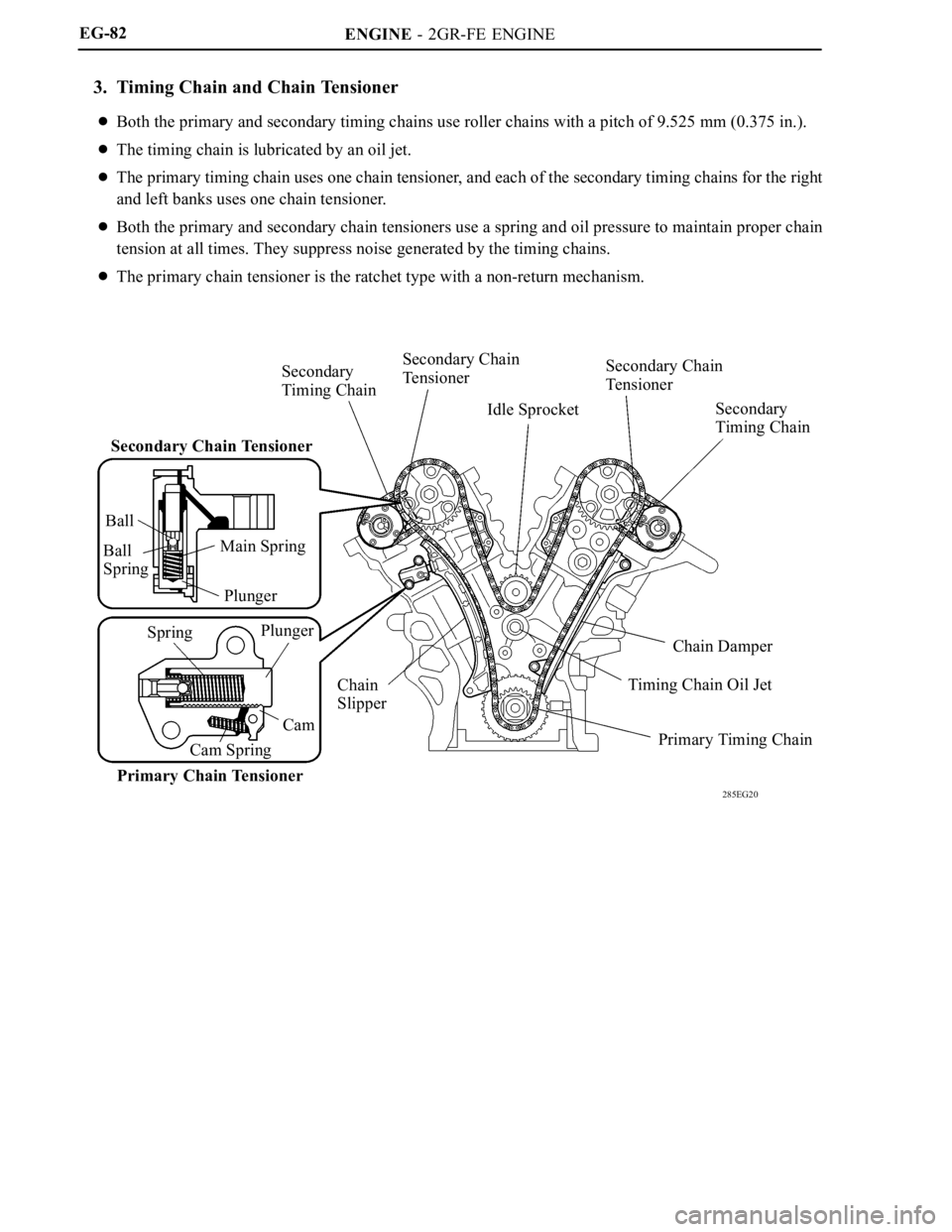TOYOTA RAV4 2006 Service Manual PDF
Manufacturer: TOYOTA, Model Year: 2006, Model line: RAV4, Model: TOYOTA RAV4 2006Pages: 2000, PDF Size: 45.84 MB
Page 71 of 2000

ENGINE - 2GR-FE ENGINE
285EG10 285EG09
60
Knock Sensor Bosses
36.6 mm
(1.441 in.)
105.5 mm
(4.15 in.)
View from Top Side
285EG11
Wa t e r P a s s a g eEG-75
4. Cylinder Block
The cylinder block is made of aluminum alloy, so it is lightweight.
The cylinder block has a bank angle of 60, a bank offset of 36.6 mm (1.441 in.) and a bore pitch of 105.5
mm (4.15 in.), resulting in a compact block in its length and width even for its displacement.
Installation bosses of the two knock sensors are located on the inside of left and right banks.
A water passage has been provided between the cylinder bores. By allowing the engine coolant to flow
between the cylinder bores, this construction enables the temperature of the cylinder walls to be kept
uniform.
Page 72 of 2000

ENGINE - 2GR-FE ENGINE
285EG12
Liner
Cylinder
Block
Irregularly shaped
outer casting
surface of liner A
A
A - A Cross Section
285EG13
Front MarkResin CoatingTaper Squish Shape
Alumite
Coating EG-76
A compact block has been achieved by producing the thin cast-iron liners and cylinder block as a unit. It
is not possible to bore the block with this liner.
The liners are the spiny-type, which have been manufactured so that their casting exteriors form large
irregular surfaces in order to enhance the adhesion between the liners and the aluminum cylinder block.
The enhanced adhesion helps improve heat dissipation, resulting in a lower overall temperature and heat
deformation of the cylinder bores.
5. Piston
The piston is made of aluminum alloy.
The piston head portion uses a taper squish shape to accomplish fuel combustion efficiency.
The piston skirt is coated with resin to reduce the friction loss.
The groove of the top ring is coated with alumite to ensure wear resistance.
By increasing the machining precision of the cylinder bore diameter, the outer diameter of the piston is
made into one size.
Page 73 of 2000

ENGINE - 2GR-FE ENGINE
285EG14
Knock Pin
Plastic Region
Tightening Bolts
285EG15
Balance Weight
Engine
Front
No. 1 Journal
No. 2 Journal
No. 3 JournalNo. 4 JournalEG-77
6. Connecting Rod and Connecting Rod Bearing
Connecting rods that have been forged for high strength are used for weight reduction.
Knock pins are used at the mating surfaces of the bearing caps of the connecting rod to minimize the
shifting of the bearing caps during assembly.
The connecting rods and caps are made of high-strength steel for weight reduction.
Nutless-type plastic region tightening bolts are used on the connecting rods for a lighter design.
An aluminum bearing is used for the connecting rod bearings.
The connecting rod bearings are reduced in width to reduce friction.
7. Crankshaft
A crankshaft made of forged steel, which excels in rigidity and wear resistance, is used.
The crankshaft has 4 journals and 5 balance weights.
All pin and journal fillets are IH-finished to maintain adequate strength.
Page 74 of 2000

ENGINE - 2GR-FE ENGINE
285EG81
Plastic Region
Tightening Bolts
Crankshaft
Bearing CapSeal WasherUpper Main Bearing
Oil Grooved
Micro-grooved
Lower Main Bearing
285EG80
Torsional Damper
Rubber EG-78
8. Crankshaft Bearing and Crankshaft Bearing Cap
The crankshaft bearing is made of aluminum alloy.
As the connecting rod bearings, the lining surface of the crankshaft bearings is micro-grooved to realize
an optimal amount of oil clearance. As a result, cold-engine cranking performance is improved and engine
vibration is reduced.
The upper main bearing has an oil groove around its inside circumference.
The crankshaft bearing caps are tightened using 4 plastic region tightening bolts for each journal. In
addition, each cap is tightened laterally to improve its reliability.
9. Crankshaft Pulley
The rigidity of the crankshaft pulley with its
built-in torsional damper rubber reduces noise.
Page 75 of 2000

ENGINE - 2GR-FE ENGINE
285EG16
Oil Pan No. 1
Oil Filter Case Oil Pan No. 2EG-79
10. Oil Pan
The oil pan No. 1 is made of aluminum alloy.
The oil pan No. 2 is made of steel.
The oil pan No. 1 is secured to the cylinder block and the transmission housing and is increasing rigidity.
The oil filter case is integrated with the oil pan No. 1.
Page 76 of 2000

ENGINE - 2GR-FE ENGINE
285EG18
Secondary
Timing
ChainExhaust Camshaft Intake CamshaftsExhaust Camshaft
Roller Rocker Arm
Va l v e S p r i n g
Retainer
Va l v e S p r i n g
Hydraulic
Lash Adjuster
Va l v e G u i d e
Bush Va l v e S p r i n g
Sheet
Va l v e
Secondary Timing
Chain Primary
Timing
Chain EG-80
VA LV E M E C H A N I S M
1. General
Each cylinder of this engine has 2 intake valves and 2 exhaust valves. Intake and exhaust efficiency is
increased due to the larger total port areas.
This engine uses roller rocker arms with built-in needle bearings. This reduces the friction that occurs
between the cams and the areas (roller rocker arms) that push the valves down, thus improving fuel
economy.
A hydraulic lash adjuster, which maintains a constant zero valve clearance through the use of oil pressure
and spring force, is used.
The intake camshafts are driven by the crankshaft via the primary timing chain. The exhaust camshafts
are driven by the intake camshaft of the respective bank via the secondary timing chain.
This engine uses a Dual VVT-i (Variable Valve Timing-intelligent) system which controls the intake and
exhaust camshafts to provide optimal valve timing according to driving conditions. With this adoption,
lower fuel consumption, higher engine performance, and fewer exhaust emissions have been achieved.
For details of Dual VVT-i control, see page EG-120.
Page 77 of 2000

ENGINE - 2GR-FE ENGINE
285EG19
VVT-i
ControllerNo. 2 Camshaft
(Exhaust)
Timing
Rotor
VVT-i ControllerNo. 1 Camshaft
(Intake)
No. 3 Camshaft
(Intake)
Timing
Rotor
VVT-i Controller
VVT-i ControllerNo. 4 Camshaft
(Exhaust)Indented R portion
of cam (Profile)
Cam with indented REG-81
2. Camshaft
The camshafts are made of cast iron alloy.
An oil passage is provided on the intake and exhaust camshafts in order to supply engine oil to the VVT-i
system.
A VVT-i controller has been installed on the front of the intake and exhaust camshafts to vary the timing
of the intake and exhaust valves.
Together with the use of the roller rocker arm, the cam profile has been designed with an indented R
(radius). This results in increased valve lift when the valve begins to open and finishes closing, helping
to achieve enhanced output performance.
Page 78 of 2000

ENGINE - 2GR-FE ENGINE
285EG20
Secondary Chain Tensioner
Primary Chain TensionerSecondary
Timing Chain
Idle Sprocket Secondary Chain
Te n s i o n e r
Secondary
Timing Chain Secondary Chain
Te n s i o n e r
Chain Damper
Timing Chain Oil Jet
Primary Timing Chain Chain
Slipper Ball
Ball
SpringMain Spring
Plunger
SpringPlunger
Cam
Cam Spring EG-82
3. Timing Chain and Chain Tensioner
Both the primary and secondary timing chains use roller chains with a pitch of 9.525 mm (0.375 in.).
The timing chain is lubricated by an oil jet.
The primary timing chain uses one chain tensioner, and each of the secondary timing chains for the right
and left banks uses one chain tensioner.
Both the primary and secondary chain tensioners use a spring and oil pressure to maintain proper chain
tension at all times. They suppress noise generated by the timing chains.
The primary chain tensioner is the ratchet type with a non-return mechanism.
Page 79 of 2000

ENGINE - 2GR-FE ENGINE
285EG21
Timing Chain Cover
Wa t e r P u m p G a s k e t
Wa t e r P u m pWater Pump Swirl
Chamber
Oil Pump
Housing
Oil Pump RotorsTiming Chain
Cover
Oil Pump Chamber
View from Front Side View from Back Side
285EG22
Oil
Passage
Check Ball
Check Ball
Spring
Plunger SpringPlunger
Roller Rocker ArmCam
Oil
Passage
Hydraulic
Lash Adjuster
Service Tip
Valve clearance adjustment is not necessary because a hydraulic lash adjuster is used in this model.
EG-83
4. Timing Chain Cover
The timing chain cover has an integrated construction consisting of the cooling system (water pump and
water passage) and the lubrication system (oil pump and oil passage). Thus, the number of parts has been
reduced to reduce weight.
5. Hydraulic Lash Adjuster
The hydraulic lash adjuster, which is located at the fulcrum of the roller rocker arm, consists primarily of
a plunger, plunger spring, check ball, and check ball spring.
The engine oil that is supplied by the cylinder head and the built-in spring actuates the hydraulic lash
adjuster. The oil pressure and the spring force that act on the plunger push the roller rocker arm against
the cam, in order to adjust the valve clearance that is created during the opening and closing of the valve.
As a result, engine noise is reduced.
Page 80 of 2000

ENGINE - 2GR-FE ENGINE
285EG23
Oil Pump
Oil FilterOil Strainer EG-84
LUBRICATION SYSTEM
1. General
The lubrication circuit is fully pressurized and all oil passes through an oil filter.
A cycloid rotor type oil pump is used.
Oil Capacity
Dry6.5 Liters (6.9 US pts, 5.7 Imp. qts)
With Oil Filter6.1 Liters (6.4 US pts, 5.4 Imp. qts)
Without Oil Filter5.7 Liters (6.0 US pts, 5.0 Imp. qts)